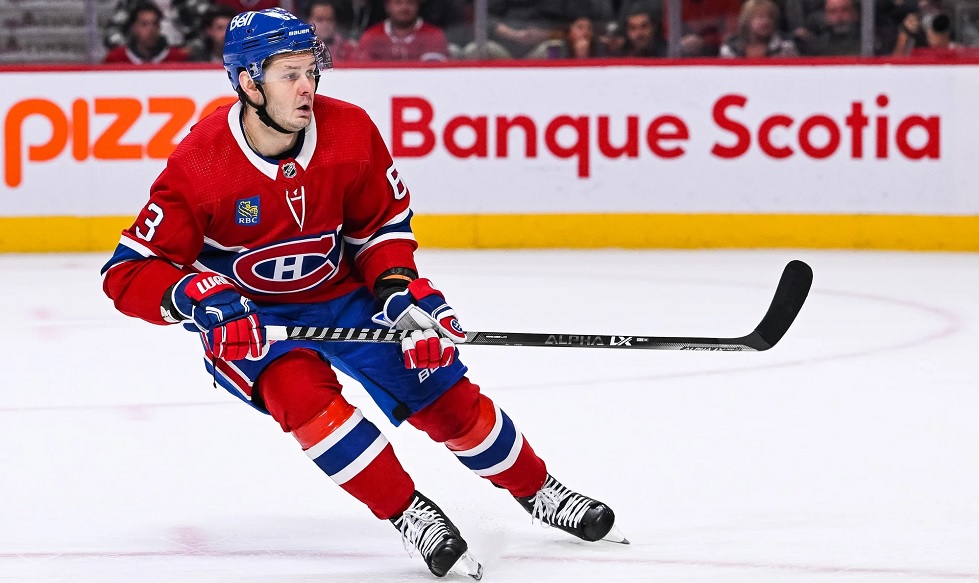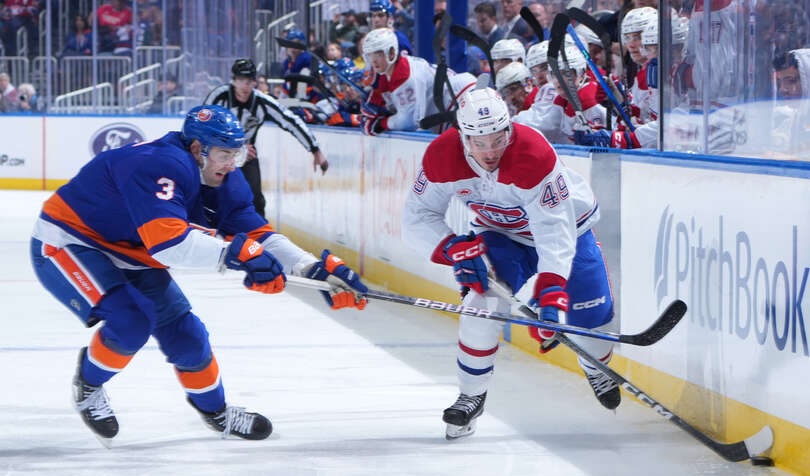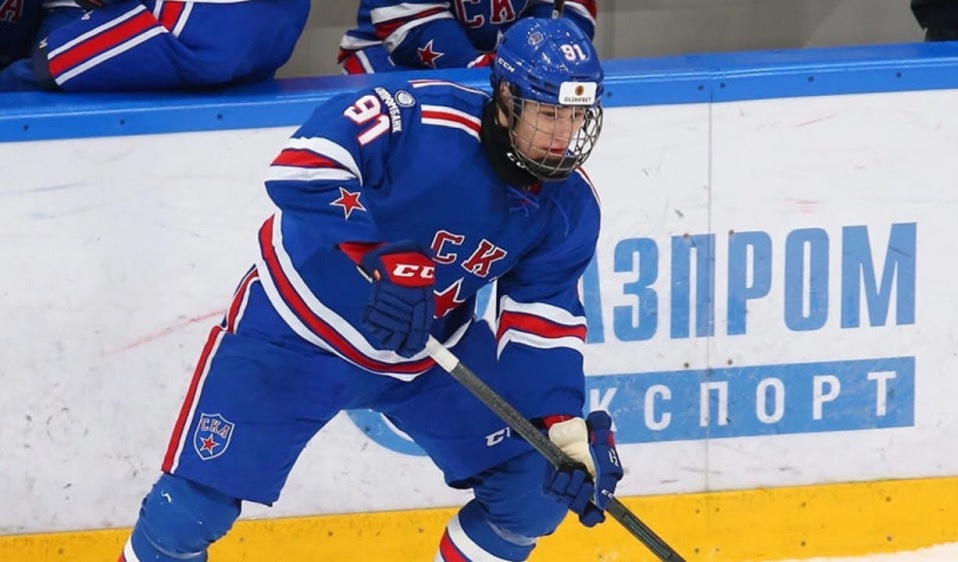HabsWorld.net --
The Habs got into the trade fun over the weekend, flipping Evgenii Dadonov with 50% retention to Dallas in exchange for Denis Gurianov. Having had some time to ponder the deal, our writers offer up their thoughts on the swap.
Terry Costaris: This is a potentially low-risk, high-reward move. Gurianov has shown in the past that he has the potential to be better, especially come playoff time. Perhaps a change of scenery will re-energize him and Montreal will have some secondary scoring and size.
If he does not pan out over the next month and a half, the Habs can walk away with nothing much to show for this deal. However, is Gurianov a better gamble than a 4th-round draft pick – which was the highest that GM Kent Hughes could extract for Dadonov? Yes.
Doing the math, Montreal has taken on $400K more against its cap which may be problematic if Hughes wants to play the middle man in a few deals by the March 3 trade deadline.
Dallas GM Jim Nill is no chump. His scouting department is in the NHL’s top tier. I doubt that Hughes has pulled a rabbit out of his hat here. I also doubt that the small gamble that the Habs have made on this transaction will result in much.
But hey, we finally have a chance to say something beyond how difficult it will be for the Canadiens to make some major, franchise-altering, trades by March 3rd or who they will draft on June 28th.
Tom Haapanen: Dadonov was unlikely to be traded for any great prize, having been gifted to the Habs in the summer and then followed that up with a slow start to the season. At the age of 34, he didn’t fit into the Canadiens’ rebuild plans, so the question was only whether Hughes would be able to secure some value for him before he walked away as an unrestricted free agent.
So, enter Gurianov, a former first-round pick who has struggled increasingly through four seasons and three coaches in Dallas. From roughly 0.5 points/game (and better yet in the 2020 playoffs), he had declined to just nine points through 43 games in the current season. A big-bodied strong winger with soft hands, a good shot, and surprisingly good speed, he nevertheless failed to produce, got moved down the lineup, struggled more and got dropped further, a spiral that is tough to break. Dallas commentators felt that he was particularly lacking in smarts and hockey IQ, and without that, he was unable to crack the top half of the lineup with either a defence-focused or offence-focused coach. From a Stars’ perspective, then, they feel that they got Dadonov, who may or may not be effective—but that they effectively got him for free.
So, the Habs have a reclamation project, another player that was not producing, and will have to see whether they can find a way to exploit those underlying skills. They have done it recently with Kirby Dach, and before with players like Jeff Petry and Samuel Montembeault, but the additional challenge here will be whether Gurianov can learn hockey IQ, think and work with the other forwards, and absorb the culture that the team is building. If he can, and he can even reach his rookie/sophomore production of 50 points per season again, the Habs will have hit a home run with this trade. On the other hand, if he fails to integrate, or if they are unable to sign him to a more reasonable contract for 2023-24, there is little value lost in this trade.
More than just a question of Gurianov being able to adapt, this will also be a test for Martin St-Louis, for him to demonstrate that hockey IQ can really be taught, and that he is able to extract more performance from players than a conventional coach might. If he can do that, the benefit for the Habs is not only the gain of an effective big winger still under team control, but also increased confidence in St-Louis’s abilities as a coach.
Allan Katz: The Dado-NOV, Guria-NOV trade is not difficult to assess.
Dallas needed a sniper to give them secondary scoring in this year’s playoffs. In Dado-NOV they got a “C” level talent that has been playing better as the season has gone on.
Montreal wanted a younger player with upside while hoping for a Kirby Dachian transformation. Guria-NOV is a skater, with size and a great hard shot who has not lived up to his potential.
If either team reaps any reward for this trade, it will be impressive.
It is possible that this trade pays off for both teams. Here’s what that might look like; Dado-NOV scores five goals between now and the end of their season. One of the goals is an overtime playoff winner. Just as possible that Dado-NOV plays poorly as he struggles adapting to his new home. Guria-NOV scores four goals in the regular season and considers re-signing for a smaller cap hit. Just as possible that Guria-NOV’s production is nil and he’s off to the KHL at the end of the regular season.
And now for the rest of the story; At first glance, this seems like a “NOV” for a “NOV” trade and, let’s be real, that’s exactly what this trade is. So what is a “NOV?” Nov is the Latin word for “New.” When teams have poor-performing players that need to be traded, they will often be exchanged for each other in the hope that new scenery will change their fortunes. It rarely works out but sometimes, who knows, it happens. The Habs got the slightly better of the trade because their New NOV is better than their Old NOV, at least in terms of potential.
Brian La Rose: Well, someone has to take the other side here so I guess it’s me. Yes, Montreal has a plethora of draft picks already but more isn’t necessarily a bad thing, especially with a management group that has discussed a desire to consolidate those selections and move up in the past. The more ammunition for that, the better. Dadonov might not have fetched much of a draft pick but that pick would have at least had some value with the Canadiens beyond this season.
The same can’t be said for Gurianov. Frankly, there’s a scenario where that’s the best outcome. While it’s possible that he could sign for below his qualifying offer, it’s not going to be at a tremendous discount. It needs to be a pricey enough deal for him to forego testing the open market for the first time. I suspect that price point is closer to the $2.9 million qualifying offer than people think.
Is keeping him around $2.5 million or so really a good outcome here? Not necessarily. Montreal has no shortage of underperforming, inconsistent forwards. It’s part of the reason they are where they are in the standings this season. Adding another one to the mix might not help all that much.
Is it possible that Gurianov turns things around and looks like a possible piece of the future with the Canadiens? Yep. Am I expecting that to happen? Not really, at least to the point where they’d re-sign him at a palatable rate. If the scenario is that or a future asset (a draft pick), the smarter play in the long run might be the future asset and the ability to be a bit more creative with retention rather than having Gurianov’s deal on the books for the stretch run. But, count me as intrigued to see how Gurianov will fare down the stretch.
Kevin Leveille: Funny how first impressions play a huge role in the perception of a player. Dadonov was brought in to offload Shea Weber’s contract. He would be flipped at about this time of the season for whatever Hughes could get, likely a late-round pick. Then the season started and he was so incredibly soft and seemingly uninterested. Stats showed this too as he scored two points in his first 18 games and the entire fan base turned on him. However, then December came around and he turned on the switch playing much better all-around and he scored 16 points in the next 31 games leading to Sunday’s trade. A little more in line with what was expected, and frankly, so is the return on this trade.
My first impression of Gurianov was like many around the league: 17 points in 27 games during the 19-20 playoffs. Wow! What a prospect! He produced at a similar pace in 19-20 and 20-21 with 29 points in 64 games and 30 in 55 games respectively. Then 21-22 saw him hit a wall as he produced 31 points in 73 games. The harsh reality for Gurianov: this is a player who has scored 9 points in 43 games this season with ice time that has gone down as the season has progressed. He is a reclamation project in its purest form and is exactly the type of player expected as a return for Dadonov when Dadonov was first acquired.
Is it a good gamble for Hughes to take? Sure. Is it the “fleece” that’s being celebrated around the Habs fan base? Hardly. Temper expectations Habs fans, or else you’ll end up liking Gurianov about as much as you enjoyed Dadonov unless Marty St. Louis can magically unlock a player that’s already been through three NHL head coaches.
Peter Longo: A year ago at the trade deadline I commented that Hughes had a pretty easy time making deals. He had players that were playing well and were sought after by other teams (Tyler Toffoli, Ben Chiarot, Artturi Lehkonen, and Brett Kulak). Aside from the Toffoli trade, Hughes was able to make easy trades picking up quality assets for players that didn’t fit into the future of the team. The real challenge was yet to come when Hughes didn’t have quality assets to trade. Such is the case this year. Clearly, Dadonov has struggled and it’s frankly shocking that any team would give up anything for him. After picking up half of Dadonov’s salary and Gurianov’s, Hughes is actually spending $400,000 more. But this minor additional cap hit is money well spent to simply remove Dadonov and open up a roster/contract spot. The fact that Hughes has also added a 25-year-old RFA who is a former first-round pick – that is all aces.
This trade deadline is when Hughes earns his paycheck. So far, he’s doing it.
Norm Szcyrek: This is a relatively low-risk trade for Montreal. Gurianov is an arbitration-eligible RFA in the offseason. If he continues to underperform for the rest of this season, Hughes can walk away from an arbitration decision and either give up on the player or sign him for much less like he did with Rem Pitlick. If the head coach and skills coach can somehow motivate him to start playing more consistently and produce offensively, then the Habs may win this deal.
As a player, he has a good package of size, speed, and a shot, so there’s hope he can turn around his game. What troubles me about him is a couple of things. If he does play well for the Habs, there is a risk the GM will sign him to a multi-year contract; I would prefer to only sign him for one season to let him prove that his quarter season was not a fluke. Gurianov has *no* defensive game, and although that’s not as big of a deal for a rebuilding Montreal squad, he doesn’t appear to be a player a contending team would typically employ. I don’t see a long-term future in Montreal for this player, but since he’s a right winger and that position has little depth with other veteran players injured, he will get a chance to play.
Dave Woodward: The Dadonov-Gurianov deal was a trade that may help both teams. In Dadonov, the Stars get an aging veteran on an expiring deal who may fit into their bottom for the rest of the season and the playoffs. For Dallas (who are in first place in their division), they are in ‘win now’ mode. Gurianov was not contributing and, from their perspective, perhaps Dadonov has something left. Since the Canadiens retained half of Dadonov’s salary, the Stars also gain some cap space (Gurianov’s salary is $2.9 million).
Of course, Dadonov’s age, 33, declining skills, and pending UFA status make it clear that he is not (and never was) part of the Canadiens’ long-term rebuilding plans. Both players have had disappointing seasons. After a twenty-goal season last year with Vegas, Dadonov has four goals. Similarly, two seasons removed from a twenty-goal season, Gurianov has two goals and only nine points this season. Apart from absorbing half the salary, the Canadiens are not losing a lot in the deal and the trade certainly does not negatively impact their rebuild. The Stars are, from their perspective, not losing a lot either. Gurianov would never have been qualified at $2.9M and he clearly did not fit into their group this season.
Nonetheless, the long-term benefits of the deal, if any, favour the Canadiens. In Gurianov, the Canadiens are acquiring a former first-round pick in 2015 who is (i) 25 years old, (ii) two years removed from a twenty-goal season; and (iii) one year removed from a 31-point season. Gurianov has some speed and some scoring prowess. He is obviously a reclamation project but his skill set may well fit into the style of play Marty St. Louis espouses.
If Gurianov, a pending RFA with arbitration rights, does not work out in the last six weeks of the season, the Canadiens will not have to qualify him. And if he works out, Gurianov is young enough to stick around at least in the short term. Unlike Dadonov, it is possible that Gurianov could be part of the organization going forward.
For that reason, while this is a minor deal, the trade makes sense for the Habs. They were not going to get much for Dadanov other than perhaps a late-round pick. In Gurianov, with a lot of luck, Gurianov could conceivably become part of their forward group going forward. With a plethora of draft picks over the next few years already in hand, taking a chance on Gurianov is most probably preferable to yet another late-round pick.


